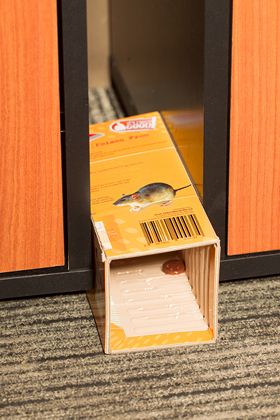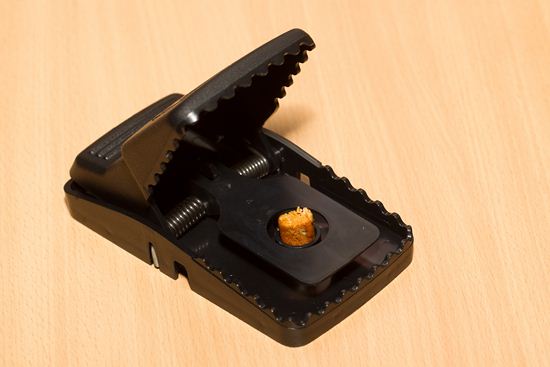You know you have a rodent problem if:
• You hear loud noises and squeaks during the night; rodents tend to make noise as they walk on the ceiling, the attic or on the floor.
• You find gnaw or bite marks on wooden structures and food containers; rodents that leave their greasy marks behind risk the contamination of your food items
• You find smear marks/foot stains/grease marks on walls and pipes; rodents’ body release an oily stain that can usually be found on their body and feet:
• You find urine trails and can most likely smell an acidic pungent smell; rodents have weak bladders and tend to dribble all over the place. Mixed with the smear marks left behind, the smell of urine can easily intensify.
• You find poop in and around active places such as food gathering areas and undisturbed resting sites; rodents are prolific poopers, meaning that they can produce 35-75 droppings per day. On the left rat feces, on the right mouse:

• You recognize weird nests built from piles of paper, cotton and other soft materials in the house or ceilings (Roof Rat); rodent nests are easy to recognize as they always make a burrow underground (usually Norway Rats) or a cozy and warm nest.
What to do when you have rodent problems:
• To catch a rat/mice in the house, I suggest to place the Controz Rodent Glue Board at those active areas that the rodent may frequently visit. This product comes with a “pre-baited scent” that acts as an attractant to rodents while it also subsequently increases the trap’s performance.
It is important to choose a “poison-free” kind of the Controz Rodent Glue Board to ensure the safety of your family members and prevent the inhaling of the toxic materials found on it. Do not place the glue board in areas where even kids and other pets can reach, for it is going to be close to improbable for rodents to get trapped in those areas because they favor secret and more hard-to-reach places as their comfort zone. The use of a good and reliable adhesive tape is necessary to minimize the success of a rodent escaping from the glue board during its struggling action once trapped. Remember: do not place the glue board at open areas where they do not touch with corners or wall edges because rodents prefer moving along the sides of the wall in order to feel more secure:



• If you find grease or smear marks in and around places where the glue board is not advised to be placed at, then use the Trapper T-Rex Rat Snap Trap and tighten it with a cable tie on the piping with a minimum of two traps side by side, one face up or left and another face down or right, to ensure a “no way run” trap for the rodent no matter which side it is coming from.
To enhance the trap’s performance and effectiveness, I suggest to place a rat’s favorite food in the Trapper T-Rex Rat Snap Trap. Always remember to handle this tool with extreme care:

 
• Once we eradicate the little munchers, our next task is to get rid of the bad smell they leave after a successful capture. The granulated All Natural Cough Odor Remover could be an excellent companion in this quest. You have to scatter the granules around the place where the rats were found, then leave it overnight. After the smell has been absorbed by the granules, vacuum them away.
• If the source of the bad smell can’t be determined precisely, you may want to hang the Earth Care Odor Remover Bag in and around the areas of the bad smell. The product uses an airborne-particle-absorbing technology to reach its purpose. Usually, one bag per room is sufficient, but for the living room, you may require 2-3 bags.
• Always wear a disposable glove and mask when removing dead rats and mice from your house, for they carry some very nasty and infectious germs that may affect your health. To do things the right way, use a Standard Snake Tong to quickly grab the rodent and throw it into a garbage bag. Make sure to tighten the plastic bag well and do not inhale from it.
• If none of the above is possible, make sure to call for the assistance of a Professional PCO.
How to prevent rodents from ever coming back:
• Prepare control plans against rodent penetration into your home.
• Use the Bytrac program as your preventive measure and squeeze the repellent gel into those small holes, cracks and crevices that the rodent could potentially utilize as an entry point
This repellent gel is an excellent way to subsequently prevent rodents from entering your house due to its “burning and hot” feel that it brings out in these creatures:

• After the Bytrac has been applied, inspect the effectiveness of the product by checking on the areas treated from time to time. It may last from 3-6 months depending on the environment, and it is also very easy to remove with soapy water.
• Re-apply again at will.
Common Species:
• Black rat (Rattus rattus)
• Brown rat (Rattus norvegicus)
• Mouse (Rattus rattus)
Interesting Facts:
• Rats are causes of many diseases due to their living conditions. They are sources of hantavirus fever, salmonellosis (food-poisoning), rat-bite fever, plague and many others.
• Plague was believed to be the cause of the death of around 50 million people during the “Black Death” in the 14th century across all Asia, Europe and Africa!
• Rats have also been accused of being a significant factor in Africa’s food crisis, for they are expert crop damaging creatures.
• Other than food contamination and disease transmission, rats have also been found as one of the reasons behind a large number of house fires as they basically bite and gnaw on everything, including the electrical wiring!
• Rats’ front teeth can grow 4 – 5 inches every year, and this is why they must chew on hard items to stop them from growing too much.
• A female rat can mate as many as 500 times with various males during a six-hour period. Given that they mate more than 15 times per year, they can easily give birth to up to 2000 rats in a single year. This fact alone warrants a more militant approach to them. |








